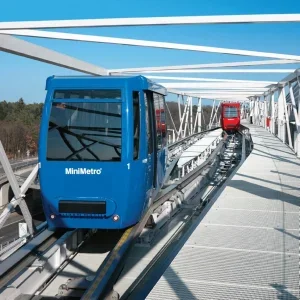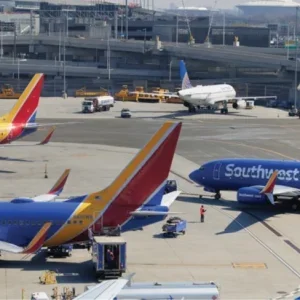On 11 March 2015, the passengers and crew of Delta 1086 should not have been flying into LaGuardia. The airport should have closed for the day. Snow and freezing rain had been falling across the tricounty area for the past couple of hours and, although the ploughs had been sent out on to the runway minutes before the pilot set the aircraft down, just enough had settled on the runway in the intervening period to make braking almost impossible.
For a moment, the plane bounced and slid along the runway at an angle, on a course that would lead it straight on to the grass to careen through the perimeter fence and into the sea. By some miracle, however, the wheels encountered just enough friction to leave the plane teetering on an embankment. Photos of the immediate aftermath of the crash show Delta 1086 propped up at an angle, as if peering through the gap in the fence to see for itself the grey waters and endless smokestacks of Flushing Bay.
A commercial aircraft is capable of landing on snow, provided it is thick enough to have been compacted into something resembling solidity. Snow that has just fallen on the runway, however, offers all the friction of an oil slick. Ice is just as unpredictable. Leave a plane out overnight in freezing temperatures and ice will inevitably build up on the wing’s control surfaces. Try to take off with that weight on the ailerons and you’ll be lucky to make it into the air.
It is for these reasons that when hub airports – such as Heathrow in 2010 and Frankfurt in 2013 – experience heavy snowfall they often opt to shut down operations entirely. Yet, as global warming makes the cold months ever more unpredictable, these airports are increasingly adopting lessons from their more northerly counterparts, who operate in areas where snow and ice are annual winter realities.
Frozen expectations
Among those airports, Helsinki-Vantaa, Finland, is a leader in minimising the effects ice and snow have on flight safety. Furthermore, it has achieved this in conditions that routinely exceed those found in the depths of winter at larger airports throughout Europe and North America. Although the Helsinki area experiences an average mean temperature of 0°C in its wintertime, snow begins to fall from November onwards and may not stop until mid-March.
"For five months of the year, we have snow and ice conditions here, so it’s been a prerequisite for us to understand and know how to deal with ice and snow," says Heini Noronen-Juhola, vice-president at Finavia, the publicly owned company that runs Helsinki Airport. "It’s never been an issue for us, really."
In fact, the first time Finavia fully realised that what it was accomplishing was unusual in global aviation came in 2010. "It was only when Heathrow closed for a week because of such conditions that we understood that we’re actually really good at this ice and snow thing," she says.
In fact, the only time Helsinki closed in its winter period was in 2003, when the air traffic control system failed. Even then, after half an hour the system was repaired and the runways reopened. It is also underscored by the remarkably low number of accidents involving any aircraft in winter conditions. According to the Aviation Safety Network, the last serious incident occurred in 2005, when a pilot mistakenly left his Cessna 208B exposed to the January night air and crashed it between the runways, because he hadn’t de-iced the wings. Prior to that, the last crash saw an Ilyushin 14M overshoot the runway in 1957.
A crucial job
The effectiveness of the system Helsinki has devised to clear snow and ice from its runway is belied by its simplicity.
"We have to separate the whole thing into two sections," explains Noronen-Juhola. "One is the airport snow clearance and general maintenance, and the second is the aircraft de-icing. The ground-handling companies outsourced by the airlines are tasked with the latter. We, however, take care of the de-icing liquids that they use, and runway maintenance and clearance."
To that end, Finavia hires up to 65 so-called ‘winter men’ to supplement its existing runway maintenance staff. "They form teams that work in three shifts all the time and they are always prepared to do the snow clearance in winter," Noronen-Juhola says. "From the beginning of October until the end of April, they’re always working in shifts of three to accomplish this."
These teams work according to predetermined snow plough patterns, formulated according to the size of the runway that needs to be cleared as well as the frequency of take-offs and landings. That being said, their success is just as attributable to the skill of the individual foreman, since snowfall is hardly a predictable phenomenon. "We have really experienced and highly trained personnel," says Noronen-Juhola. "And, of course, we train for this every winter, so we’re constantly improving on our clearance strategies."
Huge specially designed ploughs are essential in achieving this. "They work in groups of up to a dozen, simultaneously," she says. "Then we can sweep one runway in less than ten minutes, including all the connecting taxiways. At the apron area, where the planes park and do their handling, they have to deploy smaller ploughs, as they’re working in a more confined area. There, we can also have some men with shovels and so on to clear the signs."
Above all, close cooperation with the airlines operating out of Helsinki remains crucial. "We are constantly discussing with its representatives the threat of snow and ice," says Noronen-Juhola. And as the airlines are kept informed by Finavia of the prospect of new snow showers, Helsinki is kept up to date by any subtle changes in weather patterns though its advanced meteorological sensors.
"We are able to determine within five hours whether there will be a snowstorm," says Noronen-Juhola. "And if we see that one is about to occur, we collect quickly in a pre-determined way the most important airlines and ground handlers in one room for a situation meeting. We go through the case with them, and by doing that, we anticipate any problems and plan for that particular storm."
Learning lessons
There aren’t many airports that are as well prepared to tackle winter conditions as Helsinki. Nevertheless, there are a few that Finavia has kept its eye on. "We like to benchmark ourselves against Canadian airports," Noronen-Juhola says. "For instance, Toronto has the world’s best aircraft de-icing area. It is areas like those that we’re trying to learn from."
Despite this attention, it’s more often the case that Canadian airports will visit them in Finland. "We’ve had many guests from different kinds of airports," she says. "They come here to understand how we are doing things and what lessons they can learn. We’ve had Canadians; we’ve had Germans. Most of the UK airports have been here. It happens all the time."
The spectre of global warming hangs over the heads of all of these visitors. Research published in the journal Nature Geoscience by a team from the University of Tokyo in 2014 points to a weakening of the polar vortex – the set of high-altitude windflows in the Arctic Circle – caused by the melting of sea ice in the region. That, in turn, spells much harsher winters across Europe and North America, until the full disappearance of sea ice in that area in the 2030s. Airports on both continents are therefore keen to learn as many lessons as they can from those more used to such extreme conditions.
Even in Finland, the effects of global warming are starting to be felt. "Our winters have really changed," says Nuronen-Juhola. "Opposites are becoming much more dominant. We’ve had much colder periods, much stronger snow storms, accompanied at the same time by very warm winters. I’d say that 30 years ago the climate was really constant. Now, it could be anything."
Nevertheless, it is difficult to imagine the approach Helsinki has perfected over that period failing to accommodate the realities imposed by global warming. Indeed, the posture it has adopted – prudent planning informed by detailed meteorological analysis – is increasingly what is required in aviation across the northern hemisphere.
Certainly, it is not something that fazes the management at Helsinki, at least as far as Noronen-Juhola sees it. "We’re looking all the time for new technical innovations," she says. "It always requires a sort of common sense, though. It’s not really rocket science. It’s just planning, educating and training, and doing all of those things in a very skilled way."






